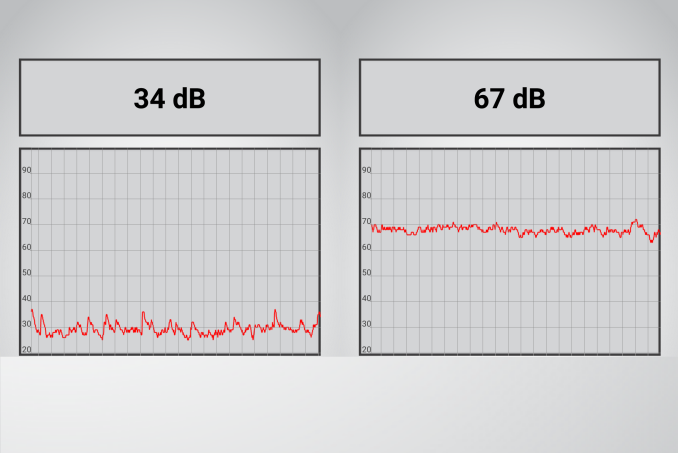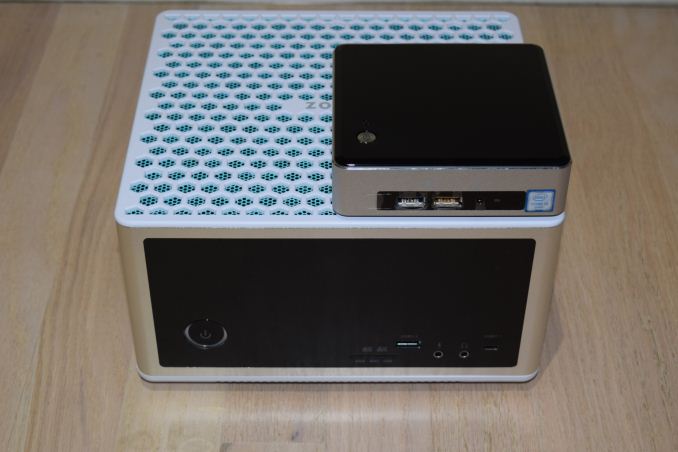Zotac ZBOX MAGNUS EN980 SFF PC Review - An Innovative VR-Ready Gaming Powerhouse
by Ganesh T S on August 25, 2016 8:00 AM ESTMiscellaneous Aspects and Concluding Remarks
Over the course of the review, I have mentioned at multiple places that the MAGNUS EN980 has a surprisingly great noise profile. In order to get a rough quantitative feel of this aspect, a Sound Meter app on the OnePlus 3 was used to graph the loudness rating. The phone was kept right on top of the chassis - equivalent to putting one's ears right on top of the unit while in operation.
At idle, the operation of the water pump and the 620 RPM fan result in loudness ratings between 28 dB and 35 dB. On the other hand, when subject to maximum stress, the rating climbs up to around 70 dB.
Coming to the business end of the review, Zotac must first be congratulated for maintaining an excellent noise profile for the PC. The compact watercooling setup has proved to be very effective. The thermal design is able to keep component temperatures low under both idle and loading conditions, preventing excessive thermal stress from shortening lifespan of components.
The EN980 and the NUC6i5SYK can make it together in a single frame, but the performance packed into the former is way out of the NUC's league - particularly from a gaming viewpoint
The EN980 is not without its faults or scope for improvement: For example, the front USB ports can't be used for booting / installing an OS (and the information is buried deep in the manual). The DDR3L memory can't be 'overclocked' by much and the BIOS options could do with some overhaul. The M.2 SATA SSD reached more than 70C for long durations with the AIDA64 System Stability test. A thermal solution for the M.2 slot is definitely needed. Most SATA drives should be fine, but, if the same chassis / cooling design is used for a NVMe drive in the future, there is some scope for overheating. We could also use some improvements in the chassis design - in particular, a carry handle of some sort for better portability - would be nice to have. It would also be useful to route one of the four display outputs to the front panel. The two power bricks solution is a bit clunky. We might get better efficiency with a slightly larger footprint and an internal slim PSU. Dated internals (no support for DDR4 SODIMMs or M.2 PCIe SSDs) are a bit disappointing for a premium machine, but those point to how long Zotac has actually been working on perfecting this product.
Make no mistake - despite the list of feedback points being longer than the list of positives, the Zotac ZBOX MAGNUS EN980 is hands-down the most innovative small form-factor machine to have come to the market in the last several years. We haven't seen something this different and impressive (in terms of CPU and GPU performance for a given size) since Intel introduced the Sandy Bridge NUCs. Credit must be given where it is due, and no praise is too less for the R&D team at Zotac for pulling this off.
Creating a technically impressive product is only one side of the equation. The product must also be priced right to have the right impact in the market. Our personal opinion is that the $1600 barebones price is a bit on the higher side. However, Zotac indicated that their market research pointed to the price being reasonable for the specifications. We have also seen that the gaming market is not as price-sensitive as the other consumer market segments, and this might lend credence to Zotac's observations.
The Zotac ZBOX MAGNUS EN980's system performance and VR-ready GPU configuration should satisfy the vast majority of gaming enthusiasts. We have a compact unit that is able to properly support a high-end desktop GPU while maintaining excellent thermal and acoustic parameters. Pretty much the only people who might find it unattractive are those who tend to upgrade components selectively over the lifespan of their gaming system, or DIY enthusiasts who want the latest and greatest in choice of components for their PC build.
We hope Zotac is committed to this chassis design and thermal solution for future products in the premium gaming mini-PC space. In the short term, the ZBOX MAGNUS EN980's internals should be updated with a Pascal GPU. When Kaby Lake comes around, we hope Zotac integrates a motherboard with more modern features. Given the cost of the unit, we are sure prospective consumers wouldn't mind a few hundred dollars more for a Z-series chipset with, say, Thunderbolt 3 and a few more USB 3.0 ports spread around the chassis.












30 Comments
View All Comments
nathanddrews - Thursday, August 25, 2016 - link
Revision 2.0 with Pascal and PCIe SSD should be interesting. The tiny design is really neat.Chaitanya - Thursday, August 25, 2016 - link
V2 with 1080 or 1070 has already been announced.nathanddrews - Thursday, August 25, 2016 - link
...ImSpartacus - Thursday, August 25, 2016 - link
That's going to be awesome. I hope they can cram some kaby lake in there as well as it'll surely have some minor improvements over Skylake.lament - Thursday, August 25, 2016 - link
Not v2 though.. different model EN10: http://techreport.com/news/30526/zotac-magnus-en10...Morawka - Thursday, August 25, 2016 - link
Tiny? this thing is huge. sure it's smaller than your typical M-ITX case but not far from it.Einy0 - Friday, August 26, 2016 - link
Is it just me or is a 250GB SSD is not enough for a gaming PC. I thought it would be enough a few years ago and quickly discovered that I was constantly shuffling games over to a HDD to make room. Most of the games from the past few years are about 40GB a piece. Looking at my current Steam folder, the Witcher 3 is 38GB and Shadow of Mordor is 42GB. With Windows 10 and a standard load of common apps and utilities, you are looking at 4 to 5 games installed. I suppose if you only use it for games it would okay.jamyryals - Thursday, August 25, 2016 - link
Looks like a terrific little box. The visual comparison to the Nuc was especially helpful to get size context. Too bad they couldn't get the Pascal cards in on this version.fallaha56 - Thursday, August 25, 2016 - link
too bad? deal breaker more like! no point being this far behind the curve...gtx1060 would wipe floor wit at every levelBrokenCrayons - Thursday, August 25, 2016 - link
It's an interesting system. As already mentioned in another comment, the NUC size comparison is useful for putting things in perspective about just how much more physical space it takes to gain gaming performance.I do question this line though:
"At this point of time, a premium gaming PC that can't be advertised as VR-ready can't get good market reception."
The monetary returns for companies producing VR hardware and VR-enabled software for consumer use isn't easy to find and we haven't had enough time or products out there to see any enduring trends about the latest round. All I've got is personal experience to work with here, but I see very little consumer demand because of the cost of entry and the unaddressed shortcomings that we saw with 90's era headgear being duplicated in current hardware.